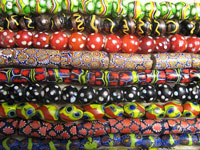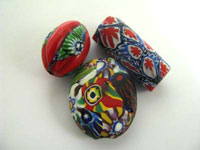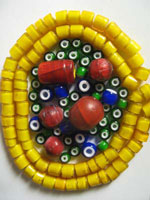Our Bead Collection
We specialise in jewellery designed using African Trade Beads, Ethiopian silver and gold, amber beads, and African-made glass beads. The term ‘African Trade Beads’ refers to beads traded throughout Africa, sometimes used as currency, and generally manufactured in Europe, but with some important beads coming from West Africa. The trade of these beads began seriously in the 1860s with many of the European beads also traded into north America, where they were particularly popular with the indigenous population in Canada and the US.
The major sources of African Trade Beads were Venice, Bohemia and Germany. 
Murano Beads
The specialist glass beadmakers from Murano, the island off Venice, were the finest of the beadmakers, making such exotic beads as chevrons, millefiori beads, fiorato beads, white heart and yellow heart beads, and special trailled beads such as the Lewis and Clark beads, skunk beads and the so-called French Ambassador beads from as early as the 16th Century. Each of these beads is a category in itself. The white heart collection includes a range of reds, oranges, yellows, blues and greens, and possibly the oldest style – the Cornaline d’Aleppo.
These beads were never traded into Africa by the beadmakers themselves, as the craftsmen were not allowed to leave the island for fear of their secret bead making techniques being shared with the rest of the world. Companies such as J F Sick (Amsterdam 1850-1964), and Levin (London 1830-1913) purchased the beads, catalogued them and traded them by the tonne throughout West and East Africa, including Ethiopia, in exchange for gold, palm oil and ivory. They were used in clothing, for decoration and as a trading item, as an alternative to coins.
This was definitely a study in relative value, since Western culture considered gold, for instance, much more valuable than the glass beads they could produce in mass quantities. To the people of Africa, on the other hand, these colourful beads became important components in both their rituals and personal adornment. Natural resources were plentiful on the African continent, but methods to produce the beautiful glass beads they desired were not.
Many of our Trade Beads are over 100 years old. The Società Veneziana Conterie (Murano 1893-1992), a type of beadmakers collective, coordinated much of the production of individual beadmakers in Murano until it finally closed in 1992. In recent decades Indian and Pakistan glass bead makers imitated (rather poorly) the Murano beads, but more recently Chinese bead makers have perfected the techniques and produced some excellent Murano-style beads.

Chevrons
With its distinctive V pattern, the chevron bead is perhaps the aristocrat of beads, as they were mainly worn by chiefs and other tribal dignitaries as a sign of their wealth and power. Serious handmade production began in the 15th Century.
The chevron ‘cane’ is built up with layers of different coloured glass – classically red, white, and blue – and when viewed in cross-section a star or floral pattern is visible. Chevrons from the African trade may have up to ten layers; however the vast majority have four to six layers. Individual beads are cut from ‘canes’ and the ends ground to a roundish finish to display the chevron pattern. Our ‘watermelon’ chevrons are made by cutting the canes and ‘pinching’ the end of the hot glass beads.

Millefiories
One of the most famous and decorative of all Venetian beads is the millefiori – ‘a thousand flowers’. Millefiori beads are produced in all sizes and colours from chevron slices forged together on a central core. The colours are endless.
It seems as if Africa absorbed almost the whole production of millefiori beads during the centuries of trade. Legend has it that they were used as ballast on ships bound for the continent. Millefiori were a highly popular bead as they were cheaper than the chevrons or other fancy beads; in one way they were the poor man’s ‘good beads’ (known as Goulamine beads in Morocco).


Skunks & Feathers
Skunks, or ‘eye beads’, are also cherished by collectors. Their designs exist from ancient times and can be seen in Egyptian, Roman and Islamic beads. They
were exported to Africa in vast amounts. Skunk beads may have simple, multiple, complex or raised ‘eyes’. The standard round black and white skunk bead can be found all over Africa and is one of the most common trade beads in the world.
The feather bead was also exported in great numbers to Africa. Typically reddish-brown in colour with the feather pattern in blue and white, rarer ones have a black or deep blue background.

Venetian Fancies
An elaborate class of bead, many Venetian fancies date back to the 16th Century. They are constructed by layering strands of different coloured glass over a single colour base bead and melting them onto the bead. Traditionally, the work was done using a lamp as the heat source, hence the name 'lampwork' beads. The term 'fancy' is usually applied if three or more colours are added in the patterns.
 White Hearts
White Hearts
White hearts are a compound bead of two layers and come in a variety of shapes: round, oval, tubular, sliced or bicone, and include the popular skunk bead. They were created as a way of stretching expensive red glass (a compound of gold) by wrapping it on a white core. Later, white hearts were produced in blue, green and yellow. Among the oldest and most expensive of the white hearts are the Cornaline d’Aleppo beads with earthy red tones, imitating carnelian stone.

The Bohemian Beads
Other glass beads were made in Bohemia (part of the present day Czech Republic) and Germany. These beads tended to be less exotic in style, but very utilitarian. Examples of these beads are the jabulani beads (sometimes referred to as pigeon eggs) and the Mali weddings beads. They were all traded by Sick and Levin. Swarovski crystal beads are among the finest of these eastern European beads, but are not strictly African Trade Beads.

African made beads
African beadmakers include the Kiffa beadmakers from Mauritania, who make the highly prized ‘spit’ beads and the Krobo beadmakers from Ghana. Ethiopians specialise in silver, gold and nickel beads, and this craft was largely based in Axum, northern Ethiopia, the fabled home of the Queen of Sheba. This craft extended to the making of beautiful hand crosses and processional crosses.

Natural beads: Amber
For many years natural ambers were traded throughout north Africa and Ethiopia, and these have become very difficult to find. The ambers found in Ethiopia were traded from Madagascar, Somalia and eastern Ethiopia. The most common, the opaque yellow amber is used purely for decorative purposes, particularly with the Oromo people of middle and southern Ethiopia, and are not considered ‘Trade Bead’. While amber from Poland is over 55 million years old, the ambers from Africa are much younger, sometimes as youthful as 300,000 years! All ambers are fossilised tree resins, and the youngest are referred to as ‘copals’. In the last 100 years various types of manufactured ambers, many also highly prized, have replaced natural ambers and are easier to find. Today, even old synthetic resin ‘amber’ beads are highly prized.
‘Amber’ remains a difficult and controversial subject for bead collectors. Coral, and imitation coral made from crushed glass are also found in our collection.


